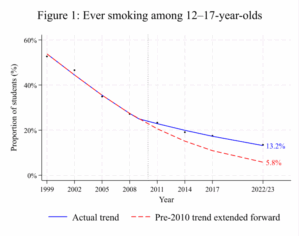New Daffodil Centre research, published in the Medical Journal of Australia, reveals that Australia’s progress in reducing adolescent smoking has slowed since about 2010, and vaping may be the reason.
The study, conducted by researchers from the Daffodil Centre, Cancer Council NSW, and the University of Sydney, analysed population-level data from more than 170,000 students aged 12–17 surveyed between 1999 and 2022/23 as part of the Australian Secondary Students’ Alcohol and Drug (ASSAD) survey.
A misunderstood trend
Sam Egger, Daffodil Centre researcher and lead author, explains that the study was motivated by a common misconception that if vaping was causing more teens to smoke, youth smoking rates would be going up:

We often hear that if vaping caused teens to smoke, we should be seeing smoking rates rise, but that’s a misunderstanding. If vaping is leading more teens to smoke, we wouldn’t necessarily see smoking rates rise. We’d more likely see smoking rates continue to fall, but at a slower pace than before vaping became available.
Sam Egger, the Daffodil Centre
Vaping’s emergence and impact
The research team compared smoking trends from 1999–2009, when vaping was rare or non-existent in Australia, with those from 2010–2022/23 when e-cigarettes emerged, becoming widely used. Five key smoking behaviours were examined: ever, past year, past month, past week, and daily smoking.
 While smoking continued to decline after 2010, the rate of decline slowed significantly across all five behaviours from 2010 onwards, coinciding with the emergence and rise of vaping in Australia.
While smoking continued to decline after 2010, the rate of decline slowed significantly across all five behaviours from 2010 onwards, coinciding with the emergence and rise of vaping in Australia.
The newly published study shows that 13.2 percent of 12-17 year olds had tried smoking by 2022/23. But if the pre-2010 smoking trend had continued, that number would have been just 5.8 percent.
Co-author Professor Becky Freeman, from the University of Sydney and Chief Investigator of the Generation Vape research project, said the findings contradict claims that vaping may be accelerating the decline in teen smoking:
Some have claimed that vaping is helping to drive teen smoking rates down faster, but our study found the opposite. Yes, smoking rates are falling — but they are falling more slowly than they were before vaping became common. That’s a real concern given how much progress had been made prior to e-cigarettes becoming available.
Professor Becky Freeman, the University of Sydney
This study is the first in Australia to examine whether the rise of vaping may have affected teen smoking at the population-level. The findings reinforce the team’s 2024 results from the Generation Vape study, which showed that adolescents who had vape are more likely to go on to try smoking than those who don’t.
Policy implications
Anita Dessaix, co-author and Chair of Cancer Council’s Public Health Committee, said this new population-level analysis adds further weight to the importance of Australia’s recent vaping policy reforms:
These results reinforce what many public health experts have feared: vaping isn’t helping kids avoid smoking — it's derailing our progress. This may have been even worse if not for Australia’s many longstanding tobacco control measures. It’s important to note that our analysis is based on data collected before the 2024 vaping reforms came into effect. Now that those reforms are in place, we need strong, coordinated enforcement to make sure they work to protect the health of young people. We are committed to supporting the strong action taken by the Commonwealth Government to regulate the sales of vapes and e-cigarettes.
Anita Dessaix, Cancer Council NSW
A regional pattern
The findings are consistent with those of a recent New Zealand analysis by the same research team, published in The Lancet Regional Health – Western Pacific, which also found that progress in reducing teen smoking slowed after 2010, following the emergence and rise of vaping in New Zealand.
“The pattern of adolescent smoking following the emergence of vaping in both Australia and New Zealand is similar – it’s hard to believe it’s just a coincidence,” Egger concludes.




